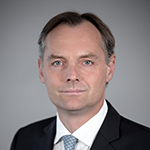Nicolas Faller says the fixed income space has lately seen a lot of interest from older people who prefer income-generating instruments.
Dubai: There is money to be made in bonds.
Amid expectations of rising rates and excessive valuations in stocks, there exist opportunities in the fixed income space, which can act as a good diversification in a portfolio.
Nicolas Faller, co-chief executive officer Asset Management at Union Bancaire Privée feels that emerging markets, high yield, private debt, credit, investment grade and catastrophe bonds offer value in the fixed income market, where bond yields are rising on the back of expectations of higher inflation.
The yields on the US 10-year treasury note jumped to as high as 2.72 per cent, the highest level since April 2014. Bond yields move inversely to prices.
“We saw a massive opportunity in fixed income for the past 5-6 years. We have seen nice yields, and we have seen one trend on interest rates which is going down. On fixed income, we are earning money because the duration that is getting down, and due to compression of spreads. Now that the story is over, you cannot expect interest rates to go down much further and the margin of spread is not what it was used to be. We see growing interest in emerging market fixed income from Latin America, Asia etc” Faller said.
“They need a shorter duration products, and also they need everything that is linked to fixed income that could provide them with some diversification”
In the Unites States, there have been inflows into bond funds since 2014. According to reports more than $36 billion (Dh132 billion) moved into bond funds in January, the biggest bet on bond funds since October 2009.
Catastrophe bonds
Other bonds that UBP prefer are the catastrophe bonds — which are high-yield debt instrument that is usually insurance-linked and meant to raise money in case of a catastrophe such as a hurricane or earthquake — for which they have been having discussions with sovereign funds and their institutional clients.
“We had some discussion over the past few days over the possibility of providing catastrophe bonds, which will provide you with good diversification which is relatively fair value. The valuation of this asset class is driven by an event. The yield that you have on your bond is linked to the fact that you have hurricane” Faller said.
“September and October has resulted in generation of higher premiums, and the assets have been re-priced. The beauty of this asset class is that there is no co-relation with other asset class compared to others because there can’t be a relation between a hurricane and a credit event” he added.
Most favoured
The fixed income market had been favoured in the past decade or so due to Basel 3 norms and other regulation for banks.
“An insurance company told me a few days ago, even if rates rises by 30 basis points, they will invest massively because there is a lot of cash to be invested. Therefore everybody is looking for any solution in the fixed income that is still giving them a decent yield” Faller said.
And, according to UBP, most of the money flow has been from older people, who prefer income generating instruments.
“There is another aspect that may be lesser known is that they are supported by flows from retail and private clients. There is probably around 85 per cent of world wealth is owned by the world, meaning the US, Europe and Japan. It is probably 80-85 per cent, and this wealth is held by relatively old people. It’s the people who are above 60. They are moving from accumulation to de-accumulation” Faller said.
So older people will prefer to invest in safer bonds compared to risky equities.
“When you are young, you acquire some wealth and then you invest in long-term assets. You don’t mind having 60-70 per cent in equities. The problem is when you move to 60-70, that’s the money to pay for pension. Gradually they are moving from equity to fixed income to have income generation” he added.
Hedge funds:
Another instrument which can provide value to clients are the hedge funds, and UBP expects hedge funds to come back in 2018 with full vigour. Hedge fund had been out of favour among investors due to subdued returns and high management fees. Due to expectations of a correction in equity markets and as investors seek ways to mitigate risk, there has been a significant increase in active management strategies, including across alternatives such as illiquid asset and hedge funds, according to Blackrock.
“With the slight normalisation and less quantitative easing, you can expect less liquidity going into everywhere, so it is easier for the hedge fund manager to extract an alpha. Since the crisis, a lot of bad managers went out of the market. Also the fees are now lower, which was always the problem given the level of interest rates. There is a growing appetite in hedge funds. People are less scared about hedge funds now” he said.

Nicolas Faller
Co-CEO Asset Management

